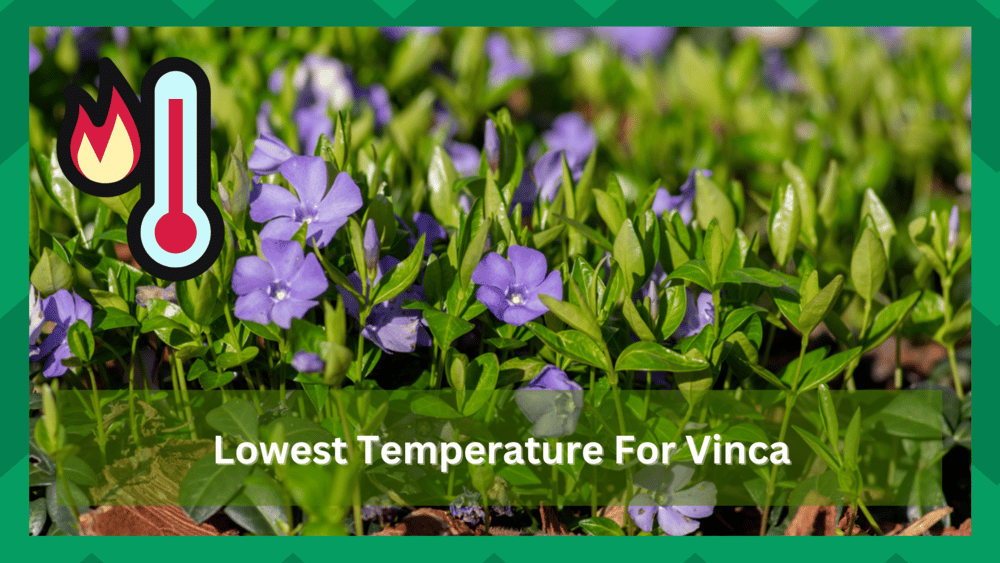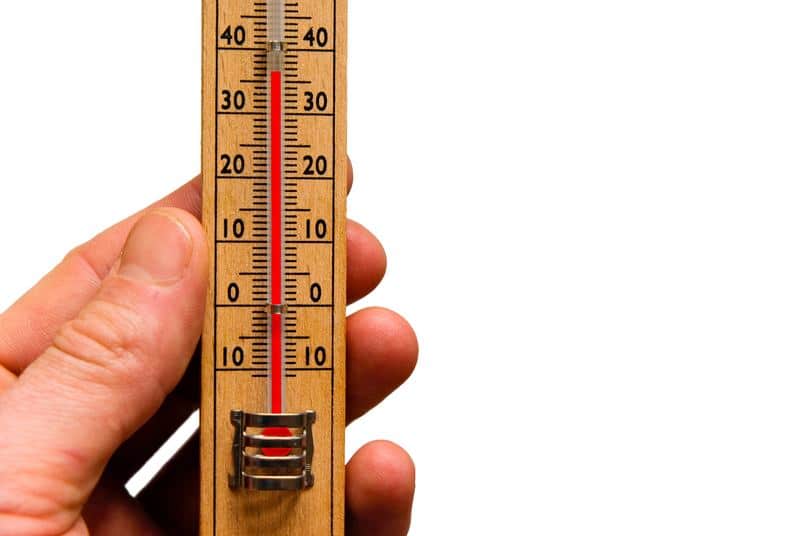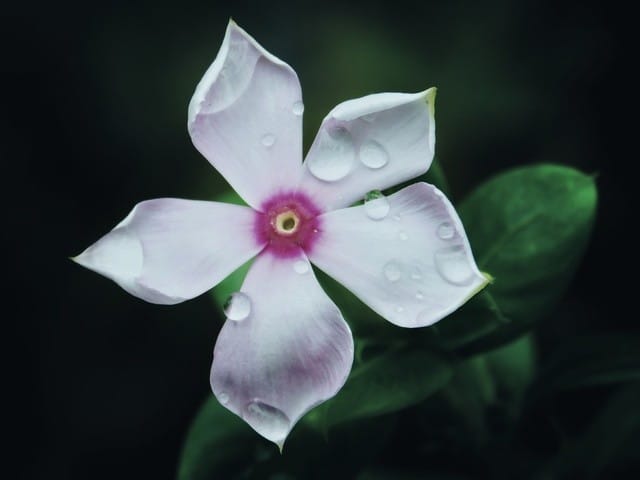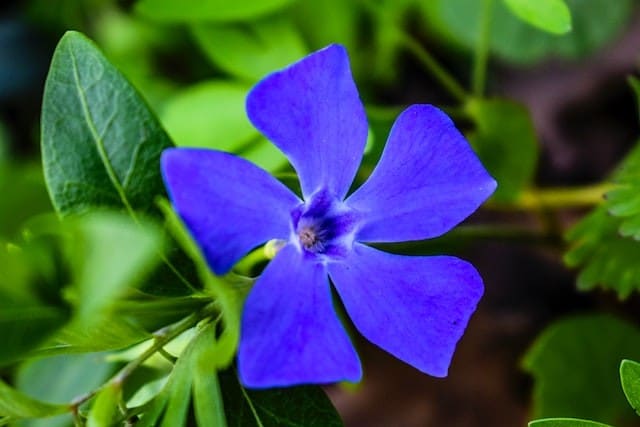
Depending on the type of flower that you want to grow, the steps required for it might vary. Considering this, ensure you understand the proper methods to keep the flowers in your home healthy. This should also help ensure that most garden problems are avoided.
Every flower needs certain weather conditions to survive, and they won’t be able to do so below a certain temperature.
Today, we’ll go along with this theme by discussing the lowest temperature for vinca. If you have these flowers in your garden and want to learn about their ideal weather conditions, check out everything we’ve mentioned below to get a good idea.
Lowest Temperature For Vinca
Vinca is one of the most common types of flowers that people worldwide grow in their homes. The main reason is how easy it is to grow and maintain the plant. However, there are also some problems that you can run into with it. One common question is, “What is the lowest temperature for vinca?”.
Regarding this, you should note that the flower is usually grown in a very warm environment.
The temperatures that you should look out for should be between 82 to 68 Fahrenheit. As long as the heat level is between this, the plant should remain healthy, and the flowers will look amazing. Vinca is drought-resistant, meaning you don’t have to water it daily.
The flower will remain healthy if the soil around it is kept moist. That said, you should remember that the temperatures mentioned above only affect the flower.
If you live in an area where the winters get colder than this, then only the flower will die. As for the plant, this can even survive during snowfall and extreme temperatures.
You can grow the flower again if the temperature is near the recommended levels when spring starts. This can be amazing and keep your garden beautiful throughout the season.
Vinca Flower and Low temperature, a ticky combination
Vinca flowers, also known as periwinkles, are beautiful flowers found in gardens and yards worldwide.
While these plants typically thrive in warm climates and full sun exposure, they can survive low temperatures if certain conditions are met. This makes them ideal for gardeners living in cooler areas who still want to enjoy their beauty.
The key to growing vinca flowers successfully in colder climates is protecting from the cold during winter and ensuring that the soil does not become too dry or wet.
During winter, it is important to mulch heavily around the base of each plant with organic material like wood chips or straw – this will provide insulation against frosty nights while also helping keep moisture levels consistent throughout different seasons.
It’s important to choose varieties of vinca flowers that are hardier than average since they will have better survival rates at lower temperatures.
When planting your Vincas, ensure their roots do not get exposed by covering them with extra soil before watering thoroughly – doing so helps protect them from extreme temperatures that could cause damage over time if left unchecked.
Proper care and maintenance allow you to enjoy a field of beautiful vinca flowers in low-temperature climates. Their resilient nature and vibrant colors make them a great addition to any garden or yard. So go ahead and try vincas – you’ll be glad you did!
The combination of Vinca flowers and low temperature is an ideal way for gardeners living in cooler climates to enjoy the colors and fragrances of these stunning flowers.
Knowing how to properly care for them in colder temperatures is key, but with the right precautions and luck, you can have beautiful vinca flowers thriving in your garden or yard all year.
With their ability to survive lower temperatures, vincas are a great choice for gardeners living in cooler climates who want to enjoy their beauty without worrying about the cold.
A few useful tips include
Make sure to cover the roots of your vinca plants before adding water to prevent them from exposure to extreme temperatures.
Choose hardier varieties since they have a better chance of surviving low temperatures.
Mulch heavily around the base of each plant in winter months for insulation against frosty nights and consistent moisture levels throughout different seasons.
With the right steps, you can have vinca flowers in delicate and vibrant colors in your garden or yard, even if temperatures get very low. So don’t hesitate to try it – you’ll be glad you did!
Winterizing Vinca
If you live in an area where the temperature gets freezing during winter, then there is a high chance that even the vinca plants might die.
This is where winterizing the roots and leaves comes in. This process helps ensure the plant is protected from all the snow so it can start growing flowers once spring returns.
The method requires you to cover the plant using organic mulch and ensure that at least it covers 6 inches of it. Leaf compost, straw, and wood chips are great for winterizing the plant. You can also cut the roots before spring to make the flowers healthier.
Tips for growing the Vinca flower:
Vinca, or periwinkle, is a flowering plant that produces beautiful blooms in shades of white, pink, and purple. It’s an easy-to-care-for perennial that can be grown outdoors year-round in most climates.
With its attractive foliage and bright flowers, vinca makes a great addition to any garden. Here are some tips on how to grow this delightful flower:
- Good Location
First, choose the right location for your vinca plants. They prefer full sun but can also tolerate partial shade, so pick a spot where they will get plenty of light but not too much direct sunlight during the hottest part of the day.
Vincas do best in soil with good drainage, so avoid areas with standing water or poorly drained soils.
- Prepare Soil
Next, prepare the soil before planting your vincas by adding organic matter such as compost or aged manure to help improve drainage and fertility.
The ideal pH range for growing these plants is 6 to 7, which you can test using a soil testing kit available at most garden centers.
After preparing the site, dig holes twice as wide as each pot containing your vinca plants and mix any added fertilizer into the backfill before planting them at their original depth from their pots. Water thoroughly after planting.
- Water Regularly
Vinca plants need to be watered regularly but avoid over-watering as this can cause root rot and other problems. You should give your plants an inch of water once a week, more if they are in hot or windy conditions, and keep the soil slightly moist but not soggy.
- Fertilizing
Vincas can benefit from regular fertilizing throughout the growing season to help promote healthy growth and more blooms. Use a balanced 10-10-10 fertilizer or other slow-release fertilizer such as Osmocote and apply it according to the instructions on the label.
- Pruning
Vincas can get leggy and unruly over time, so it’s a good idea to prune them back at least once a year. This will help keep them compact and encourage more blooms. Pruning should be done in late winter or early spring before new growth begins.
- Deadheading
Deadheading spent blooms will also help encourage more blooms and tidy up the plant. Simply pinch off or snip away any faded flowers to keep them looking their best.
What to avoid when growing the Vinca flower in low temperatures?
Vinca flowers are a beautiful addition to any garden, but they can be difficult to grow in low temperatures. When growing Vinca flowers in cold climates, several things should be avoided.
First and foremost, it is important not to overwater the plants as this will cause them to rot quickly when temperatures drop below freezing.
Mulching around the base of the plants is beneficial for insulation purposes; however, too much mulch can trap moisture and increase disease risk.
It is also important to avoid fertilizing late in the season as this could encourage new growth, which would likely be damaged by frost or extremely cold weather conditions.
Pruning should generally be limited during colder months since removing foliage may reduce the plant’s ability to survive winter conditions.
By following these simple tips for avoiding common mistakes when cultivating Vinca flowers in low temperatures, gardeners can enjoy their vibrant blooms all season long.
Conclusion:
Vinca flowers are a beautiful, easy-to-care-for perennial that can add color and texture to any garden.
When growing them in colder climates, it is important to avoid common mistakes such as overwatering, too much mulch, late-season fertilizing, and excessive pruning. By following these tips, gardeners can enjoy the beauty of Vinca flowers all season long.




